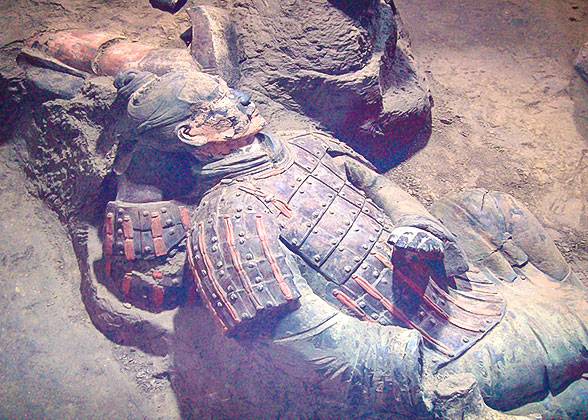Let’s Smash the 5 Rumors of the Terracotta Army
1. The Terracotta Army was owned by Qin Shi Huang, not his great-great-grandmother Mi Yue.
The power of the Qin State was not strong enough during the actual rule of Mi Yue, and the construction of such a large-scale Terracotta Army was not possible until the reign of Qin Shi Huang (259 BC - 210 BC) in consideration of finance, manpower, etc.
According to the date engraved on the weapons of Terracotta Army, these weapons were made during Qin Shi Huang’s reign. If the owner of the Terracotta Army was Mi Yue, how could it be possible that the accompanied weapons were forged more than 50 years later than her death?
The Qin terracotta warriors and Greek sculptures are famous all over the world. And the rumor appeared that ancient Greek Artists guided the construction of Terracotta Army. But in many ways, the two kinds of statues are fundamentally different.
First of all, the terracotta warriors and horses of China were made of clay, then caved and fired, whereas the Greek sculptures were mostly made of stone.
Secondly, their ways of artistic expressions were different. Ancient Chinese craftsmen carved out the head, including the hair, beard, eyebrows and so on of the terracotta warriors in very details to highlight different characters of each warrior. But the other part of the body were basically mass-produced. The Greeks paid special attention to the beauty of the human body, so they gave more attention to the body curve. Ancient Greek sculptures are muscular, with tall straight noses, broad shoulders and narrow waists, very different from terracotta warriors.
3. The Terracotta Warriors are not as Garish as Rumored.
 |
| Terracotta Warriors in Color |
The terracotta warriors and horses are indeed not the earth color that people see now. At the very beginning, they were all painted with colors. But the colors fell off in minutes after being exposed to the air.
The rumor that terracotta warriors were originally multicolored is not true. The terracotta warriors' armors are basically black and brown, tied with bright red ropes, and this color decoration is uniform. Senior officers wore purple gowns with bright colored ribbons on their armor, and the lightly armed archers wore ochre gowns. Some soldiers in the heavily armored infantry wore red gowns, while others wore green gowns. In short, the terracotta warriors are not all black and gray in color, nor are they as garish as many people think.
![]() Read more: True Colors of Terracotta Warriors
Read more: True Colors of Terracotta Warriors
4. Humans were not Sealed in the Terracotta Warrior.
Because the terracotta warriors were indeed vivid, so some people rumored that they were made of real people like this: Humans were wrapped by a layer of gauze and then sealed with mud and then burned in a kiln. Is there really such cruelty in history?
According to the excavation results, no human remains have been found inside the terracotta warriors. The terracotta warriors have hollow tops and solid legs and feet, all made of clay.
![]() Read more:
Read more:
How the Terracotta Warriors were Made
Were the Terracotta Warriors Made of Real Human Beings?
5. Terracotta Warriors are Bareheaded not Because They do not Have Helmets.
From late July 1998 to January 1999, the archaeological team found 36 stone helmets woven with copper wire in Pit K9801 to the southeast of the tomb of the Qin Shi Huang, which proved the army of Qin Shi Huang also used helmets. There are several reasons why the terracotta warriors don't wear helmets.
First of all, heavy helmets influence their movement during the wall. Also, the Qin army was very brave and offensive rather than defensive. Thirdly, the helmets were not used in a large scale for metal at that time was rare and was more often used to make weapons like swords and arrows. At last, these warriors are the guards of Emperor of Qin Shi Huang in his after life; they are saluting to show the respect to their owner and bareheaded to show their braveness.
![]() Read more: Bareheaded! Why didn’t the Terracotta Warriors wear helmets?
Read more: Bareheaded! Why didn’t the Terracotta Warriors wear helmets? ![]() Further Reading:
Further Reading:
3 Mistaken Reports of Terracotta Warriors’ Returning to Life
